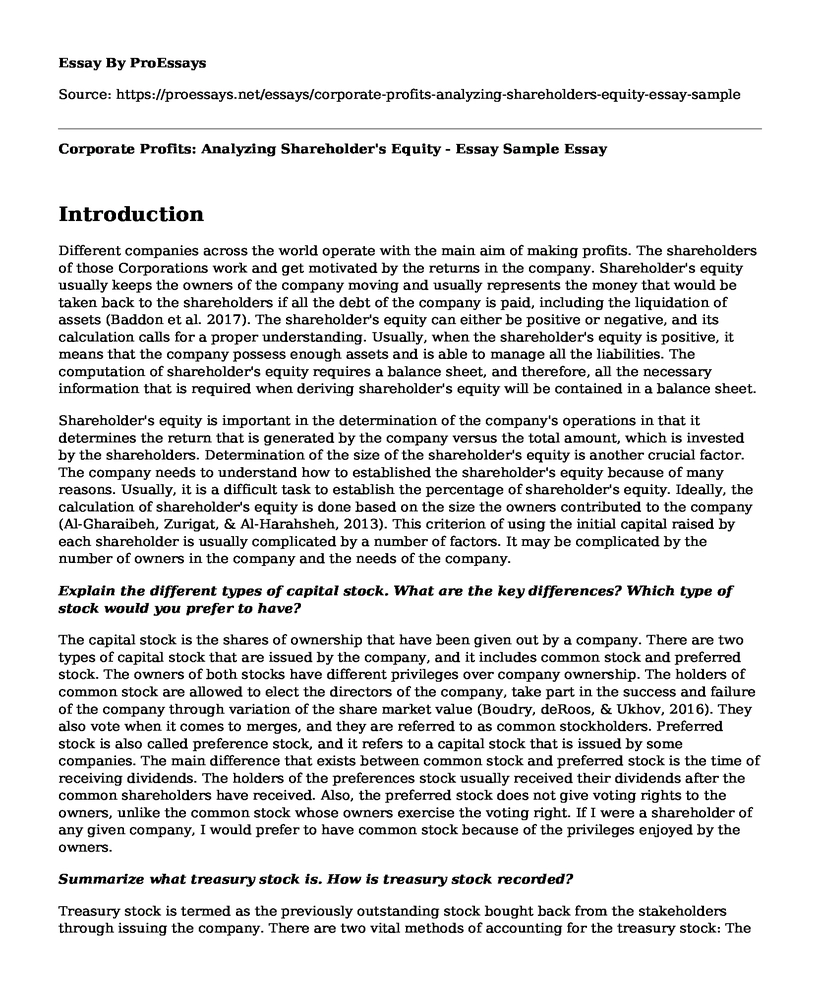Introduction
Different companies across the world operate with the main aim of making profits. The shareholders of those Corporations work and get motivated by the returns in the company. Shareholder's equity usually keeps the owners of the company moving and usually represents the money that would be taken back to the shareholders if all the debt of the company is paid, including the liquidation of assets (Baddon et al. 2017). The shareholder's equity can either be positive or negative, and its calculation calls for a proper understanding. Usually, when the shareholder's equity is positive, it means that the company possess enough assets and is able to manage all the liabilities. The computation of shareholder's equity requires a balance sheet, and therefore, all the necessary information that is required when deriving shareholder's equity will be contained in a balance sheet.
Shareholder's equity is important in the determination of the company's operations in that it determines the return that is generated by the company versus the total amount, which is invested by the shareholders. Determination of the size of the shareholder's equity is another crucial factor. The company needs to understand how to established the shareholder's equity because of many reasons. Usually, it is a difficult task to establish the percentage of shareholder's equity. Ideally, the calculation of shareholder's equity is done based on the size the owners contributed to the company (Al-Gharaibeh, Zurigat, & Al-Harahsheh, 2013). This criterion of using the initial capital raised by each shareholder is usually complicated by a number of factors. It may be complicated by the number of owners in the company and the needs of the company.
Explain the different types of capital stock. What are the key differences? Which type of stock would you prefer to have?
The capital stock is the shares of ownership that have been given out by a company. There are two types of capital stock that are issued by the company, and it includes common stock and preferred stock. The owners of both stocks have different privileges over company ownership. The holders of common stock are allowed to elect the directors of the company, take part in the success and failure of the company through variation of the share market value (Boudry, deRoos, & Ukhov, 2016). They also vote when it comes to merges, and they are referred to as common stockholders. Preferred stock is also called preference stock, and it refers to a capital stock that is issued by some companies. The main difference that exists between common stock and preferred stock is the time of receiving dividends. The holders of the preferences stock usually received their dividends after the common shareholders have received. Also, the preferred stock does not give voting rights to the owners, unlike the common stock whose owners exercise the voting right. If I were a shareholder of any given company, I would prefer to have common stock because of the privileges enjoyed by the owners.
Summarize what treasury stock is. How is treasury stock recorded?
Treasury stock is termed as the previously outstanding stock bought back from the stakeholders through issuing the company. There are two vital methods of accounting for the treasury stock: The first method is referred to as the par method and cost method (Slater, J., & Deschamps, M. 2015). Under the par value, what happens is normally at exactly the time where shares are repurchased; the treasury stock account is always debited; it is done in order to decrease the shareholders' equity right at the par values of shares under repurchase. On the opposite side, cost method involves the use of the value paid by the company at the repurchasing of shares while ignoring their par value.
References
Al-Gharaibeh, M., Zurigat, Z., & Al-Harahsheh, K. (2013). The effect of ownership structure on dividends policy in Jordanian companies. Interdisciplinary journal of contemporary research in business, 4(9), 769-796.
Baddon, L., Hunter, L., Hyman, J., Leopold, J., & Ramsay, H. (2017). People's Capitalism?: a critical analysis of profit-sharing and employee share ownership. Routledge.
Boudry, W. I., deRoos, J. A., & Ukhov, A. D. (2016). The Role of REIT Preferred and Common Stock in Diversified Portfolios.
Slater, J., & Deschamps, M. (2015). college accounting. Prentice-Hall.
Cite this page
Corporate Profits: Analyzing Shareholder's Equity - Essay Sample. (2023, Mar 20). Retrieved from https://proessays.net/essays/corporate-profits-analyzing-shareholders-equity-essay-sample
If you are the original author of this essay and no longer wish to have it published on the ProEssays website, please click below to request its removal:
- Why Do You Do What You Do ?Walmart Company
- Research Paper on Walmart's Behaviors, Actions, and Communications
- Globalization and Technology: Case Study of Walmart Paper Example
- Evaluation Essay on Apple Inc: Visioning Process and Mission Statement
- Amazon: A Premier Employer Despite Challenges in HR Recruiting - Essay Sample
- Nike: World's Leading Sports Brand and Manufacturer of Shoes - Essay Sample
- Apple Inc: Pioneering Global Innovation and User Experience - Essay Sample







